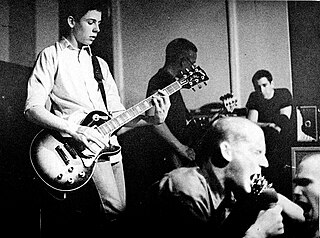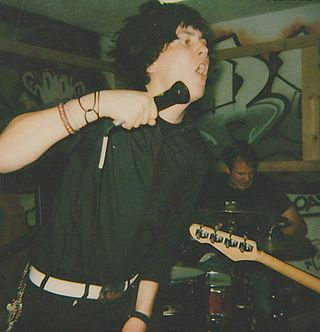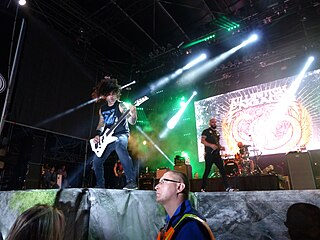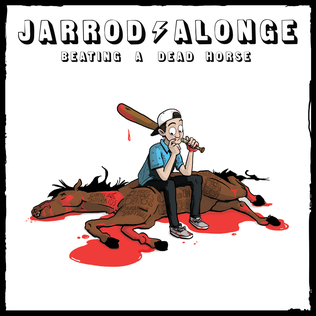
The punk subculture includes a diverse and widely known array of ideologies, fashion, and other forms of expression, visual art, dance, literature, and film. Largely characterised by anti-establishment views, the promotion of individual freedom, and the DIY ethics, the culture originated from punk rock.

Hardcore punk is a punk rock music genre and subculture that originated in the late 1970s. It is generally faster, harder, and more aggressive than other forms of punk rock. Its roots can be traced to earlier punk scenes in San Francisco and Southern California which arose as a reaction against the still predominant hippie cultural climate of the time. It was also inspired by Washington, D.C., and New York punk rock and early proto-punk. Hardcore punk generally disavows commercialism, the established music industry and "anything similar to the characteristics of mainstream rock" and often addresses social and political topics with "confrontational, politically charged lyrics".
Emo is a music genre characterized by emotional, often confessional lyrics. It emerged as a style of hardcore punk and post-hardcore from the mid-1980s Washington, D.C. hardcore scene, where it was known as emotional hardcore or emocore. The bands Rites of Spring and Embrace, among others, pioneered the genre. In the early-to-mid 1990s, emo was adopted and reinvented by alternative rock, indie rock, punk rock, and pop-punk bands, including Sunny Day Real Estate, Jawbreaker, Cap'n Jazz, and Jimmy Eat World. By the mid-1990s, Braid, the Promise Ring, and the Get Up Kids emerged from Midwest emo, and several independent record labels began to specialize in the genre. Meanwhile, screamo, a more aggressive style of emo using screamed vocals, also emerged, pioneered by the San Diego bands Heroin and Antioch Arrow. Screamo achieved mainstream success in the 2000s with bands like Hawthorne Heights, Silverstein, Story of the Year, Thursday, the Used, and Underoath.
Pop-punk is a rock music fusion genre that combines elements of punk rock with power pop or pop. It is defined by its fast-paced, energetic tempos, and emphasis on classic pop songcraft, as well as adolescent and anti-suburbia themes. It is distinguished from other punk-variant genres by drawing more heavily from 1960s bands such as the Beatles, the Kinks, and the Beach Boys. The genre has evolved throughout its history, absorbing elements from new wave, college rock, ska, rap, emo, boy band pop and even hardcore punk. It is sometimes considered interchangeable with power pop and skate punk.

The U.S. state of Washington has been home to many popular musicians and several major hotbeds of musical innovation throughout its history. The largest city in the state, Seattle, is known for being the birthplace of grunge as well as a major contributor to the evolution of punk rock, indie music, folk, and hip hop. Nearby Tacoma and Olympia have also been centers of influence on popular music.

Screamo is an aggressive subgenre of emo that emerged in the early 1990s and emphasizes "willfully experimental dissonance and dynamics". San Diego-based bands Heroin and Antioch Arrow pioneered the genre in the early 1990s, and it was developed in the late 1990s mainly by bands from the East Coast of the United States such as Pg. 99, Orchid, Saetia, and I Hate Myself. Screamo is strongly influenced by hardcore punk and characterized by the use of screamed vocals. Lyrical themes usually include emotional pain, death, romance, and human rights. The term "screamo" has frequently been mistaken as referring to any music with screaming.

Metalcore is a fusion genre combining elements of extreme metal and hardcore punk, that originated in the late 1980s. Metalcore is noted for its use of breakdowns, which are slow, intense passages conducive to moshing, while other defining instrumentation includes heavy guitar riffs often utilizing percussive pedal tones and double bass drumming. Vocalists in the genre typically perform screaming, more popular bands often combine this with the use of standard singing, usually during the bridge or chorus of a song. However, the death growl is also a popular technique within the genre.
Post-hardcore is a punk rock music genre that maintains the aggression and intensity of hardcore punk but emphasizes a greater degree of creative expression. Like the term "post-punk", the term "post-hardcore" has been applied to a broad constellation of groups. Initially taking inspiration from post-punk and noise rock, post-hardcore began in the 1980s with bands like Hüsker Dü and Minutemen. The genre expanded in the 1980s and 1990s with releases by bands from cities that had established hardcore scenes, such as Fugazi from Washington, D.C. as well as groups such as Big Black, Jawbox, Quicksand, and Shellac that stuck closer to post-hardcore's noise rock roots. Dischord Records became a major nexus of post-hardcore during this period.

Travis Brandon Richter is an American musician, singer and record producer. He is known for being a vocalist and guitarist in the band From First to Last and the lead vocalist of The Color of Violence and The Human Abstract. He is also a record producer and in 2018 cofounded a music venue in Los Angeles, CA called "1720", with Alex Alereza (Nekrogoblikon) and Brett Powell.
Emo pop is a fusion genre combining emo with pop-punk, pop music, or both. Emo pop features a musical style with more concise composition and hook-filled choruses. Emo pop has its origins in the 1990s with bands like Jimmy Eat World, the Get Up Kids, Weezer and the Promise Ring. The genre entered the mainstream in the early 2000s with Jimmy Eat World's breakthrough album Bleed American, which included its song "The Middle". Other emo pop bands that achieved mainstream success throughout the decade included Fall Out Boy, the All-American Rejects, My Chemical Romance, Panic! at the Disco and Paramore. The popularity of emo pop declined in the 2010s, with some prominent artists in the genre either disbanding or abandoning the emo pop style.
Crunkcore is a musical fusion genre characterized by the combination of musical elements from crunk, post-hardcore, heavy metal, pop, electronic and dance music. The genre often features screamed vocals, hip hop beats, and sexually provocative lyrics. The genre developed from members of the scene subculture during the mid 2000s. Notable crunkcore artists include Brokencyde, Millionaires, Dot Dot Curve, and Blood on the Dance Floor.
Electronicore is a fusion genre of metalcore music with elements of various electronic music genres, often including trance, electronica, and dubstep.
The emo revival, or fourth wave emo, was an underground emo movement which began in the late 2000s and flourished until the mid-to-late 2010s. The movement began towards the end of the 2000s third-wave emo, with Pennsylvania-based groups such as Tigers Jaw, Algernon Cadwallader and Snowing eschewing that era's mainstream sensibilities in favor of influence from 1990s Midwest emo. Acts like Touché Amoré, La Dispute and Defeater drew from 1990s emo and especially its heavier counterparts, such as screamo and post-hardcore.

Beating a Dead Horse is the debut studio album by YouTube comedian Jarrod Alonge, self-released on May 26, 2015. The album features seven different fictitious bands created by Alonge to satirize the tropes and characteristics of alternative music genres such as metalcore, post-hardcore, pop punk, emo, progressive metal, hardcore punk and others.
Emo rap is a fusion genre of hip hop and emo music. Originating in the SoundCloud rap scene in the mid-2010s, the genre fuses characteristics of hip hop music, such as beats and rapping, with the lyrical themes, instrumentals, and vocals commonly found in emo music. Lil Peep, XXXTentacion, and Juice Wrld are some of the most notable musicians in the genre.

Mall goths are a subculture that began in the late-1990s in the United States. Originating as a pejorative to describe people who dressed goth for the fashion rather than culture, it eventually developed its own culture based around nu metal, industrial metal, emo and the Hot Topic store chain. It has variously been described as a part of the goth subculture, as well as a separate subculture simply influenced by goth.












